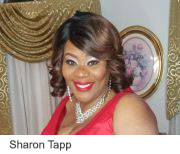
Nurse case manager Sharon Tapp recalls laying in a Bethesda, Md., hospital bed, feverishly ill from COVID-19, asking for a bedpan.
Then, in what seemed to be the very next moment, she found herself in another bed in an unfamiliar room at what seemed to be a different hospital, surrounded by people she didn’t know.
“It was like, why am I here? I woke up and I was like, Johns Hopkins? I didn’t come here,” Tapp, 60, said in a voice still raspy from a healing tracheotomy. “I was looking around at all the people, and I was like, why am I here?”
Tapp was there because she’d just survived a months-long battle with COVID-19, a fight that required doctors to put her in a medically induced coma after flying her by helicopter to Johns Hopkins Hospital in Baltimore.
Tapp’s illness was so severe that at one point she needed a heart bypass machine to provide oxygen to her disease-battered body, said Dr. Alba Azola, a physical medicine and rehabilitation resident at Hopkins.
“It’s basically the bypass machine they use for open heart surgery,” Azola said. “They have to circulate the blood outside your body to oxygenate it because your lungs are not capable of oxygenating your blood.”
Tapp spent a month on the machine, “which is really unheard of. It’s a really long time,” Azola said.
“COVID pneumonia completely prevented her lungs from being able to provide oxygen,” Azola said. “The inflammation of her lungs was such that she could not oxygenate her blood through her lungs.”
Tapp and Dr. Azola on hospital discharge day
Tapp’s ordeal started in early March, while she was on the job at Veterans Affairs Medical Center in Washington, D.C.
She suspects she contracted COVID-19 from a patient with whom she spent about 10 minutes “delivering my spiel” about her role in his medical care. Soon afterward, the patient was transferred to an isolation room and tested positive for coronavirus.
About two weeks later, on March 18, Tapp started experiencing fatigue, weakness, chest pain, a high temperature and headache. Her local urgent care center tested her for COVID-19 and told her to quarantine for 14 days at her home in Lanham, Md., based on her flu-like symptoms.
Five days later, the urgent care center called her to let her know that she’d tested positive for coronavirus. With a temperature of 102 degrees, Tapp asked her boyfriend to drive her to the emergency room at Suburban Hospital, a Johns Hopkins medical center in Bethesda.
“The folks saw me walking in and they knew. They said, ‘This girl needs help.’ They took me in right away,” Tapp said.
Tapp’s condition continued to worsen, and within 10 days of her admission she was transferred to Johns Hopkins Hospital in Baltimore — not that she knew it, because she was out of it by then.
Tapp wound up spending a total 117 days in the hospital, including two months in a medically induced coma.
Doctors transferred Tapp between intensive care and cardiac care units, keeping her alive with various equipment as she fought off double pneumonia and heart and lung failure. At one point she was on a ventilator, the bypass machine, and a dialysis machine because her kidneys had shut down.
Tapp awoke with a tracheal tube in her throat and a feeding tube in her stomach.
Tapp laughs when she recalls how, right after she woke up, none of the medical staff wanted to break the news about how long she’d been unconscious and deathly ill.
“A lot of people walked through the room, doctors and everybody. They said, ‘Miss Tapp, you look so good!’ I would say to myself, well, how was I looking before?” she chuckled. “Everybody’s coming through, the physical therapists, the respiratory specialists: ‘Oh, Miss Tapp, you look SO good!'”
Then her family came in and broke the news about what she’d been through during the past couple of months.
Tapp has spent the weeks since her awakening going through rehabilitation. She had to relearn how to perform basic tasks like standing, walking, swallowing, chewing and sipping from a straw.
She still needs a walker to get around and oxygen if she exerts herself too much, but she’s no longer on dialysis.
“Considering where she came from to where she is today, it’s just a miracle,” Azola said.
Tapp has worked at the VA Medical Center for 13 years, where she coordinates and assist veterans with their discharge from the hospital. She plans to return, but “not this year! Not in 2020,” Tapp said. “I really got to get myself together. It’s a long recovery road.”
Her advice to the healthy?
“Wear a mask. Wash your hands. Social distance. Those are the three things I would tell people,” Tapp said. “It’s no joke. It’s a serious thing. You know, I really don’t still have a taste. People ask me, what are you going to eat when you get home? Right now, I don’t have a taste.”
More information
The U.S. Centers for Disease Control and Prevention has more about COVID-19.
Source: HealthDay
Copyright © 2025 HealthDay. All rights reserved.

Leave a Reply